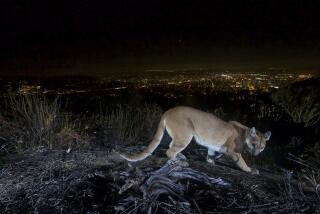The Wise Guy : No one escapes the sting of writer T. Coraghessan Boyle’s satire. This time, rich Angelenos--a breed he’s quite familiar with--are the ones feeling it.
It’s tough living in Los Angeles.
But, then, hardship is relative--as T. Coraghessan Boyle’s sixth novel, “The Tortilla Curtain” (Viking), makes pointedly clear.
Take the sad story of Kyra Mossbacher, a hotshot realtor who lives in an upscale Topanga Canyon tract recently carved into the chaparral.
A native Angeleno, Kyra has endured earthquake, flood and fire. But when Nature goes after her beloved dog Osbert, it’s more than she can bear.
The sight of a coyote bounding off with her little Dandie Dinmont terrier is “one of the worst experiences of her life, maybe the worst.”
Judging from the howls of public outrage that follow such attacks, plenty of Southern Californians would empathize with Mossbacher’s pain.
Boyle, however, puts the canine-eat-canine world of suburban L.A. into perspective.
Even as Mossbacher gulps down sedatives to cope with her loss, you see, Candido Rincon and his pregnant wife, America, are scratching out an existence in a nearby canyon, sleeping in the dirt and scavenging food like feral dogs.
There is some irony, these days, in Boyle rubbing salt in the gash that separates California’s haves and have-nots.
That irony is not lost on him.
“I’m an equal opportunity satirist,” he says as he sits on a porch at his Frank Lloyd Wright-designed home in Montecito--a ‘hood chock-full of mansions owned by the likes of Michael and Arianna Huffington.
“I make fun of everybody, including and especially myself.”
In the New Yorker magazine’s summer reading issue, Boyle does just that, describing a decidedly Boylesque character like this:
“A skinny man in his late 40s with kinky hair and a goatee who dressed like he was 25 and had a dead-black morbid outlook on life and twisted everything into the kind of joke that made you squirm.”
Indeed, with that matted tumbleweed hair and chin mop--not to mention the earrings--Boyle might be seen as a parody of the archetypal Angeleno artiste.
There’s little doubt, though, that Boyle takes even his self-satire seriously. In the New Yorker, for instance, he goes on to tweak his “genius” character’s legendary ego--an exercise in egomania itself.
That can hardly be blamed on Boyle alone. In the last decade the media and critics have fed that ego like naughty children hurling fruit to a zoo gorilla.
While he does have detractors, admirers have actually called his prose “a symphony of words.” One reviewer even compared his wordsmithery to someone “juggling a thousand gems with kaleidoscopic control.”
More than a few old news clips about him use the word brilliant. And almost everyone extends that rarest of literary compliments to Boyle, saying that he is certifiably funny.
Which is why the prolific author is now a bit nervous, in a Woody Allen kind of way.
“I’m a little sensitive about this book,” he says. “I’m a wise guy, I’m very ironic, I make fun of things and I tell jokes--and this time I didn’t.”
Or, at least, not as relentlessly.
“There is that element of satire,” he concedes. “I really can’t help myself--that’s the way I see things.
“But I tried to reel that in, so it really isn’t a comic satire so much as the kind that makes you shake your head. The intent of the book is to sweep you up and move you and involve you emotionally.”
*
The butt of the jokes this time is a breed of affluent Angeleno whom Boyle came to know in the years he lived in Woodland Hills.
Kyra Mossbacher lives with husband Delaney, their Nintendo-addled 6-year-old son, a Siamese cat named Dame Edith, and--at least initially--their two little terriers. Their home in the sprawling Arroyo Blanco development is Spanish Mission-style (floor plan #A227C, Rancho White with Navajo trim).
Each drives a Lexus, Delaney’s accessorized with a vanity plate reading PILGRIM, after the “Pilgrim at Topanga Creek” nature column he writes for an environmental journal.
Indeed, the Mossbachers are, in their way, a perfect family, bound by the sort of shared beliefs and ideals that give meaning to many Southern Californians:
“They were both perfectionists, for one thing. They abhorred clutter. They were joggers, nonsmokers, social drinkers, and if not full-blown vegetarians, people who were conscious of their intake of animal fats. Their memberships included the Sierra Club, Save the Children, the National Wildlife Federation and the Democratic Party. They preferred the contemporary look to Early American or kitsch. In religious matters, they were agnostic.”
This harmony of values begins to fray, however, as the couple confronts its true place in Nature’s grand scheme.
It may or may not be relevant to the novel at hand that before the conversation on his porch turns to literature, Boyle nudges it onto the unusual tangent of botanical Darwinism.
“There’s a war here between two types of trees,” he says, gesturing at the surrounding greenery with a hand that sports a silver skull ring.
“This is a black acacia,” he says, pointing at an eye-level bough. “So is this, right up here. It grows in two ways: by seeds, but also by runners.”
The acacia’s prime adversaries, Boyle says, are the Victorian box trees. “Those two things are fighting for dominance of this yard.”
Boyle’s words transform the seemingly tranquil landscape into a jungle, the lush flora grappling in a knot of full nelsons and strangleholds.
Boyle doesn’t pursue the potential analogy. But his view of the yard is not unlike his view, in “The Tortilla Curtain,” of a Southern California where human transplants of various ethnicities struggle to take root and survive.
Boyle makes this point in “Curtain” by cutting back and forth between viewpoints.
For Kyra, there is an advantage to illegal immigration: “It had driven the entire white middle class out of Los Angeles proper and into the areas she specialized in: Calabasas, Topanga, Arroyo Blanco.”
But her wrath is inflamed by the unsightliness of day laborers, whom she sees as impediments to selling her monstrous, often unoccupied listings in the hills.
Candido, on the other hand, is repulsed by the sterility of the domesticated “gringos.” Venturing into a store, he observes that “these people sanitized their groceries just as they sanitized their kitchens and toilets and drove the life from everything. . . .”
It is America’s first trip to El Norte from the village of Tepoztlan, Mexico, but she knows this: “To succeed, to make the leap, you had to suffer.”
And she does: rape, robbery, poisoning--you name it.
Meanwhile Delaney, the naturalist, finds his bird-watching bliss under assault. Everywhere he hikes, he sees litter left by the illegal immigrants who live off what little is left of a landscape strewn with scabby developments like Arroyo Blanco.
Soon, those immigrants become entwined with the natural predators in his mind. As Delaney’s “community” erects ever more imposing barriers against all that is “them”--fences to keep out coyotes, footings to ward off snakes, walls to hold back the imagined human ne’er-do-wells--his own liberal sensibilities erode.
*
Boyle knows he’s swinging his satiric hook pretty close to home on this.
“I might meet people like Delaney and Kyra at a cocktail party,” he says. “But that’s all the more reason to criticize them, and make them aware perhaps of what they really sound like, you know?”
There was no problem in researching them, of course. For Candido and America, it was a different matter. Boyle does not take a journalistic approach to research. He observes carefully, reads, then lets his imagination fill in the blanks, he says.
These are times, though, when territorialism spills over into the cultural realm as well. Is Boyle concerned that someone may object to an Irish American writer assuming the viewpoint of Mexican illegal immigrants?
“I’m concerned about everything,” he says, smiling in a way that seems to satirize his own supposed insecurity.
Then he comes out slugging. “If you’re a good writer of fiction, you can inhabit anybody. I’ve written about Mexicans before. I have written stories set in Ireland, on the moon, in Africa, from the point of view of blacks, Asians . . . and I feel that’s my prerogative. And anyone who feels that that isn’t my prerogative, well, they can write their own book--from my point of view if they want.
“I feel it’s a little silly to talk about how you can only write about someone of your own race or class. I mean, come on, that’s taking political correctness to the level of fascism, isn’t it?
“I don’t think that goes with art. I think art has no boundaries of ethnicity, race, political correctness or anything else. Is it good or not? That’s all that matters.”
More to Read
Sign up for our Book Club newsletter
Get the latest news, events and more from the Los Angeles Times Book Club, and help us get L.A. reading and talking.
You may occasionally receive promotional content from the Los Angeles Times.







